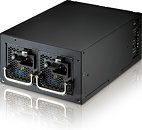Tuesday, May 24th 2016

FSP Readies a Redundant PSU for Standard ATX Desktops
Fortron's channel brand FSP is ready with a unique new redundant power supply for standard ATX desktops. The new Twins Series PSU is an ATX-size box that encloses two hot-swappable 500W server-grade PSUs, with internal circuitry that maintains redundancy. The PSU further interfaces with your OS, giving you control over redundancy, monitoring, and programmable alerts. The PSU is ideal for home-servers and workstations with <500W power draw. Each of the two included subunits features 40 mm server-grade fans. FSP plans to reveal more information at its 2016 Computex exhibit.

30 Comments on FSP Readies a Redundant PSU for Standard ATX Desktops
1U-4U server chassis are ridiculously expensive.
My family pictures are critical to my "mission" as "keeper of the data." That said, I'd never buy a 1U chassis for them. I might consider this for a simple ATX backup server though.
I see where you are coming from though...
Especially considering that ATX PSUS can remain in use for more than half a decade, you'd have to make a removable li-ion pack. PSUs are already highly packed with electrical components, a PSU with a UPS and sufficient battery size would be incredibly expensive, not to mention much bigger then the ATX standard.
ni-mh? sure, trickle charging is great.
I would hate replacing a battery inside of a UPS because to do it properly, you should disconnect the battery from the mains and the device it powers before extracting the battery itself. That would be a lot of work.
Not to mention, batteries get hot under load and adding that heat to the heat of the PSU itself does not add up to anything good.
tl;dr: If your entire system earning you thousands an hour relies on a single box regardless of the redundancy inside the server itself, I would argue you've already made a terrible mistake.
You can't always "azure-up" the server if it borks out. We have certain machines that we absolutely cannot host in the cloud.
At home it is great, in a work environment? I for sure can't see it.
As far as cooling goes (@Caring1 ) I only agree that a single 40mm fan might be a little small for each unit. However, one might mod it by add a large fan strategically placed, cant really tell from that one image alone, but it looks like the sides and top lack air holes.
www.newegg.com/Product/Product.aspx?Item=N82E16817338047&cm_re=redundant_power_supply-_-17-338-047-_-Product
If someone uses Athenapower in their system - that's when you should be worried.